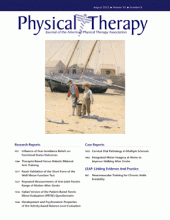<LEAP> highlights the findings and application of Cochrane reviews and other evidence pertinent to the practice of physical therapy. The Cochrane Library is a respected source of reliable evidence related to health care. Cochrane systematic reviews explore the evidence for and against the effectiveness and appropriateness of interventions—medications, surgery, education, nutrition, exercise—and the evidence for and against the use of diagnostic tests for specific conditions. Cochrane reviews are designed to facilitate the decisions of clinicians, patients, and others in health care by providing a careful review and interpretation of research studies published in the scientific literature.1 Each article in this PTJ series summarizes a Cochrane review or other scientific evidence on a single topic and presents clinical scenarios based on real patients or programs to illustrate how the results of the review can be used to directly inform clinical decisions. This article focuses on a patient with chronic ankle instability who has re-sprained his ankle and is now unable to participate in sports. Could a neuromuscular training program improve his functional outcomes?
Ankle sprain, in particular injury to the lateral ligament complex of the ankle joint, is one of the most frequently encountered lower-limb injuries in sporting populations.2 In the acute phase, ankle sprains are associated with pain, swelling, ecchymosis, and loss of function, with up to one quarter of all injured people being unable to attend work for more than 7 days postsprain.3 In addition to restricted joint range of motion and increased joint laxity, common clinical and research findings are disruption in neuromuscular control as manifested by decreased postural stability, altered muscle activation patterns, and aberrant joint physiological and accessory movement.
In the weeks following an ankle sprain, activities of daily living can be compromised, and, even though acute symptoms resolve, persistent symptoms …












